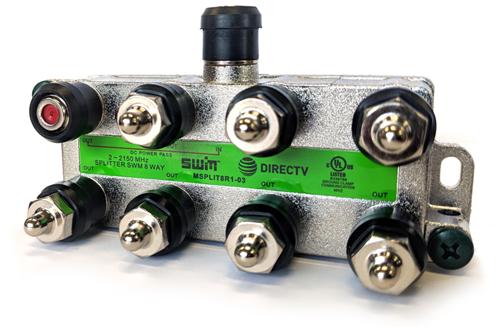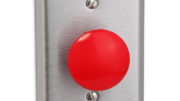This DIRECTV splitter may look like pretty much every other splitter in the world, but it’s not. It’s a specialized piece of equipment designed to distribute DIRECTV signals and not much else. Now, the retired engineers in the crowd are going to tell you that a splitter is a splitter, and yeah they’re kind of right. There’s just a little bit extra to a DIRECTV splitter that makes it very good for splitting DIRECTV signals, and very bad for splitting other kinds of signals.
That little bit is called a crossover and it isn’t the sort of thing you usually want in a splitter. In a DIRECTV splitter, signals in the satellite range of 950-2150MHz come in the top and go out the 8 output ports. If you were to put a 1700MHz signal in one of the output ports, it wouldn’t go anywhere. On the other hand, if you connected a 550MHz signal to the output ports, it would travel to all of the other output ports and back out the input!
Why do DIRECTV splitters work this way?
This is on purpose of course. It’s the special feature of these splitters that lets you share programs between a Genie DVR and other receivers, and between the Genie DVR and the Genie Mini Clients. Without it, you would only have one-way communication and none of the magic parts of the DIRECTV system would work.
It’s important to understand that Genie clients don’t actually receive satellite signals at all. All the reception is done by the Genie DVR or server. The clients themselves receive network information from the Genie DVR or server and display it. They also receive signals from the remote control and relay them back to the Genie DVR or server. That’s pretty much all they do.
The signals sent between DVR and client don’t interfere with the satellite signals, because they’re on different frequencies. The network communication is in the range of 475-625MHz, which is lower than the satellite signals.
So, is there any use for DIRECTV splitters other than using them for a DIRECTV system?
Honestly, no there is not. If you’ve replaced all the splitters in your home, then just responsibly recycle the DIRECTV ones. They do have some circuitry in them which means that your local laws may classify them as electronic waste.
What’s good for DIRECTV is bad for antennas
That’s great for DIRECTV, but it’s the exact opposite of what you want for a cable or antenna system. You see, those same frequency ranges that cross over from port to port are used for TV signals in cable and antenna signals. Any stray signals across the wire will cross from port to port and that could mean interference or picture quality problems. In short, you don’t want that.
That’s why I say, if you are going from DIRECTV to antenna, replace all the splitters. Even the cheapest possible antenna splitters have better “port isolation” (they don’t allow signals to cross over) than DIRECTV splitter. You see, DIRECTV splitters specifically allow crossover signals in TV frequencies. That’s the way they should work. That’s what makes them unique.
The good news for you is that Solid Signal has an excellent selection of splitters that work perfectly for antennas. Take a look, choose the one you want, and take down those DIRECTV splitters if you’re not going to need them.





